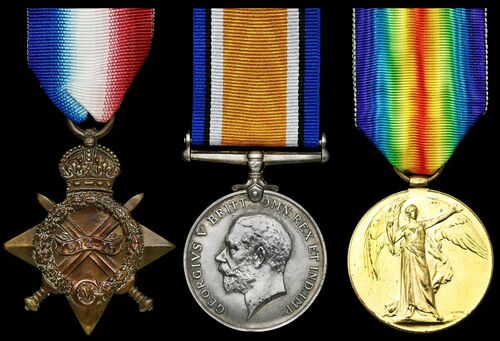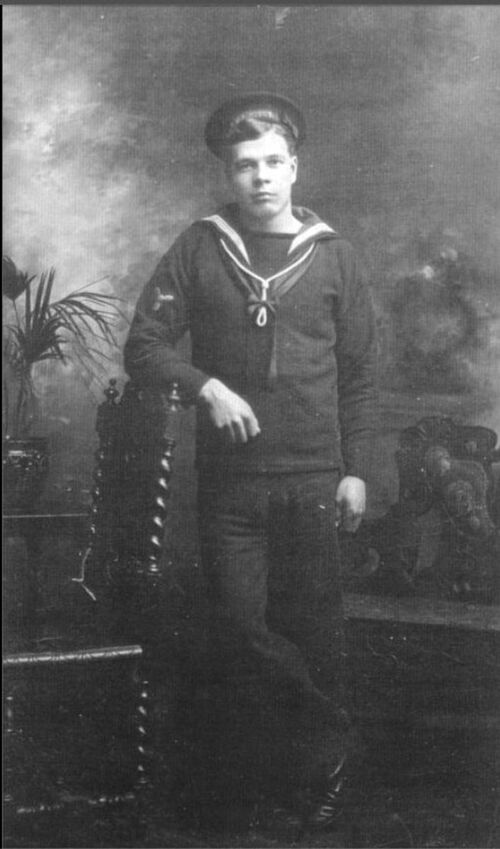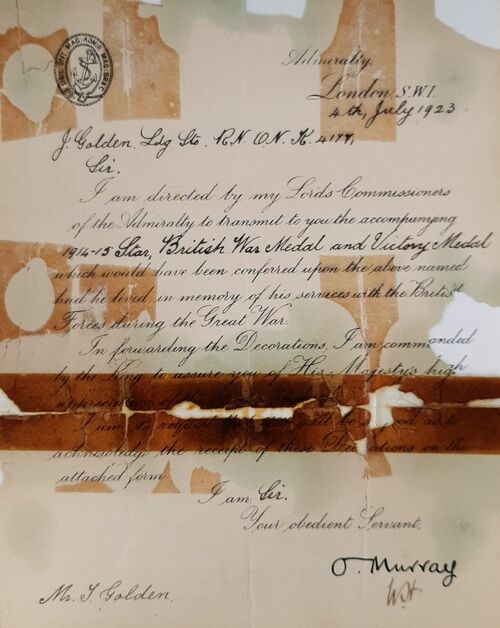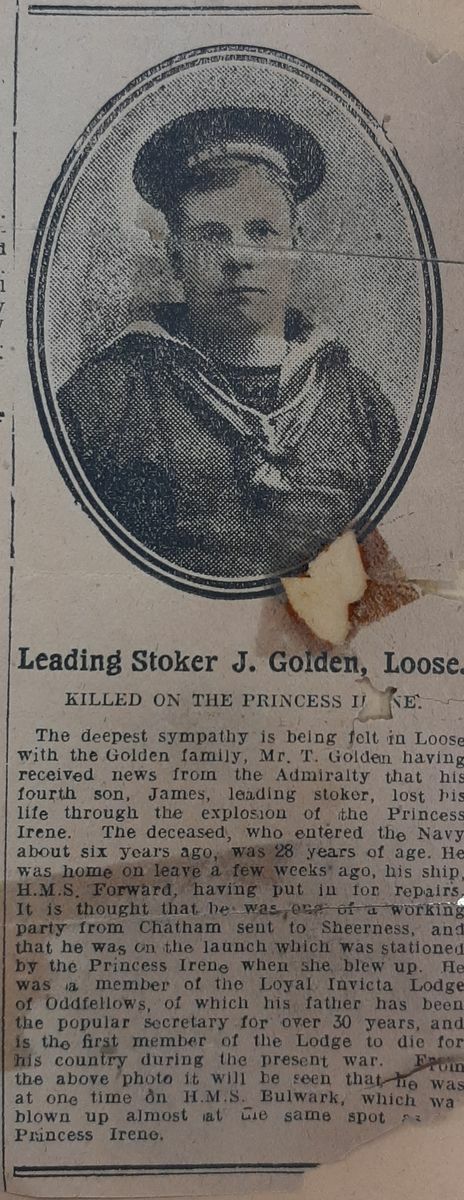Auction: 23112 - Orders, Decorations and Medals - e-Auction
Lot: 439
'But the rain of debris was so thick that we were compelled to seek shelter in the cabin and when we were able to emerge again there was no sign of the Princess Irene upon which we had been working only a few hours before. The scene was extraordinary immediately after the accident. The ship appeared to have been blown into minute fragments, many of which seemed to hang in the air burning. The force of the explosion was vertical and a pall of black and white smoke hovered high over the spot for some minutes and then began to drift away into a solid mass'
(The horrifying testimony of Mr Kilpatrick to The Sheerness Times having witnessed the destruction of H.M.S. Princess Irene)
A tragic 'loss of the Princess Irene' casualty's trio awarded to Leading Stoker J. Golden, Royal Navy, who served with the cruiser Forward during the Bombardment of Hartlepool and was later lost in the sudden destruction of the auxiliary minelayer Princess Irene which detonated while at anchor in the mouth of the Thames
1914-15 Star (K.4177. J. Golden. L.Sto., R.N.); British War and Victory Medals (K.4177 J. Golden. L.Sto. R.N.), flan on BWM a little thin in places as issued, edge bruising and minor contact wear, very fine (3)
James Golden was born at Maidstone Kent on 20 April 1887, the son of Thomas and Caroline Golden of Hawthorne Cottage, Loose, Maidstone. Enlisting on 29 September 1909 as Stoker Class II he joined Acheron that same day before being posted to H.M.S. Bulwark on 23 March 1910.
With her he was advanced to Stoker Class I on 1 October 1910 a rank he was to serve in for the next two years before reaching his final position of Leading Stoker on 6 November 1912, while with H.M.S. St. George. Upon the outbreak of the Great War Golden was stationed with the destroyer H.M.S. Bat as part of the 8th Destroyer Flotilla.
The Bombardment of Hartlepool
Removing to the scout cruiser Forward, he joined her with the 9th Flotilla at Hartlepool alongside the Patrol. Both were in port on the morning of 16 December 1914 when a powerful German Fleet including two Battlecruisers, Seydlitz and Moltke appeared over the horizon. This fleet opened fire on the town while the two coastal batteries were unable to make a dent in reply.
Patrol got underway and left the harbour to confront the intruders but Forward found herself unable to make steam. While Patrol was engaged by the armoured cruiser Blucher in the channel Forward was attempting to get underway. Despite desperate efforts she was not to emerge from the port until the German warships were already in retreat.
Princess Irene
After the raid Forward was posted to the 7th Destroyer Flotilla in the river Humber. Golden was posted ashore on 20 April 1915 and joined the shore establishment Pembroke II. From here he was posted to the minelayer Princess Irene, originally built as a passenger liner she was now operating out of Sheerness, Kent.
The raids on Hartlepool, Scarborough and Whitby had caused a great deal of concern over the vulnerability of the British coastline. Part of the response was a programme of minelaying which took place over the coming months, Princess Irene took part in this- laying over 400 mines in early May before returning to Sheerness to rearm.
She arrived there on 26 May, starting to take on mines as soon as possible. The morning of the next day she was still lying at anchor with a barge and boat- number 263- alongside her. Suddenly an enormous explosion ripped through the vessel, destroying her totally and wiping out all but one of her crew. Lieutenant Arthur Notley aboard the trawler Scott observed the holocaust stating that:
'the explosion occurred by her mainmast, well abaft of her funnels. This was a yellowish white flame which rose to about 60 ft. and was accompanied by a dense volume of dark brown smoke that completely and suddenly enveloped the vessel. Between three and five seconds later there was a second, dull, explosion, quite distinct from the first, and this time there was no flame but a large amount of white smoke rising inside a column of black smoke which assumed a much greater altitude.'
(Blown to Eternity - The loss of HMS Princess Irene, refers)
Aftermath
The wreckage of the vessel was blasted as far as twelve miles from the site of the explosion. Four oil tanks at the Isle of Grain Fuel Depot were punctured by pieces of debris and- tragically- nine year old child named Hilda Johnson was killed in her garden by part of the Princess Irene. A farm labourer in a nearby field suffered a fatal heart attack and an electrical fitter died of head injuries caused by a chunk of steel plate bursting through the wall of a coaling ship chart house. One of the stricken vessel's boilers landed upon the deck of the same coaling ship, causing further injury and damage.
Windows in nearby Chatham were shattered and panic seized the surrounding area for some time afterwards. Along with debris personal items were scattered over the surrounding area including boots, monogrammed serviettes and a tin of condensed milk.
Only one crewman survived, Stoker David Wills, one of working party aboard for the refitting of the vessel and at the time was in the galley, although his memory as to the events of the explosion was totally blank. It is entirely possible that Golden known to Willis as- according a newspaper article entitled killed on the Princess Irene- 'It is thought that he was one of a working party from Chatham sent to Sheerness, and that he was on the launch which was stationed by the Princess Irene when she blew up'.
Such was the nature of the explosion very few of the crew's bodies could be recovered, little of what was discovered was identifiable. It is unknown if any part of Golden's physical remains were found however he is remembered upon the Chatham Naval Memorial; sold together with the recipient's original medal slip of issue, a newspaper cutting relating to the recipient's death and a copy of Blown to Eternity - The loss of HMS Princess Irene along with copied research comprising a Commonwealth War Graves certificate and photocopies of the original documents present with the lot.
Subject to 20% VAT on Buyer’s Premium. For more information please view Terms and Conditions for Buyers.
Sold for
£220
Starting price
£100











